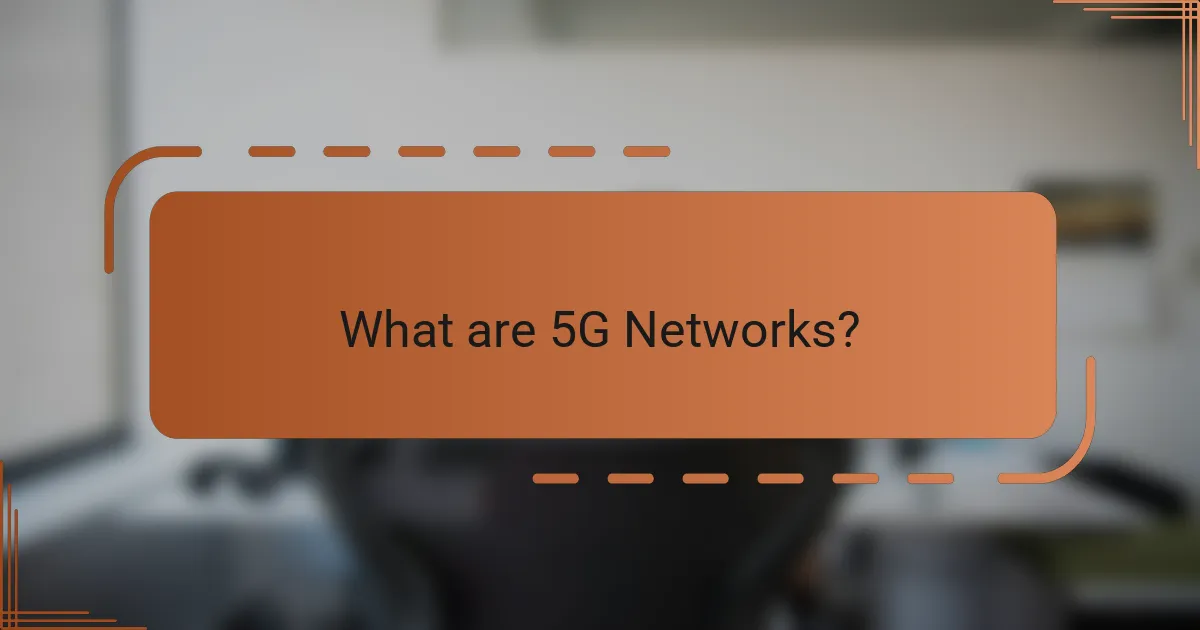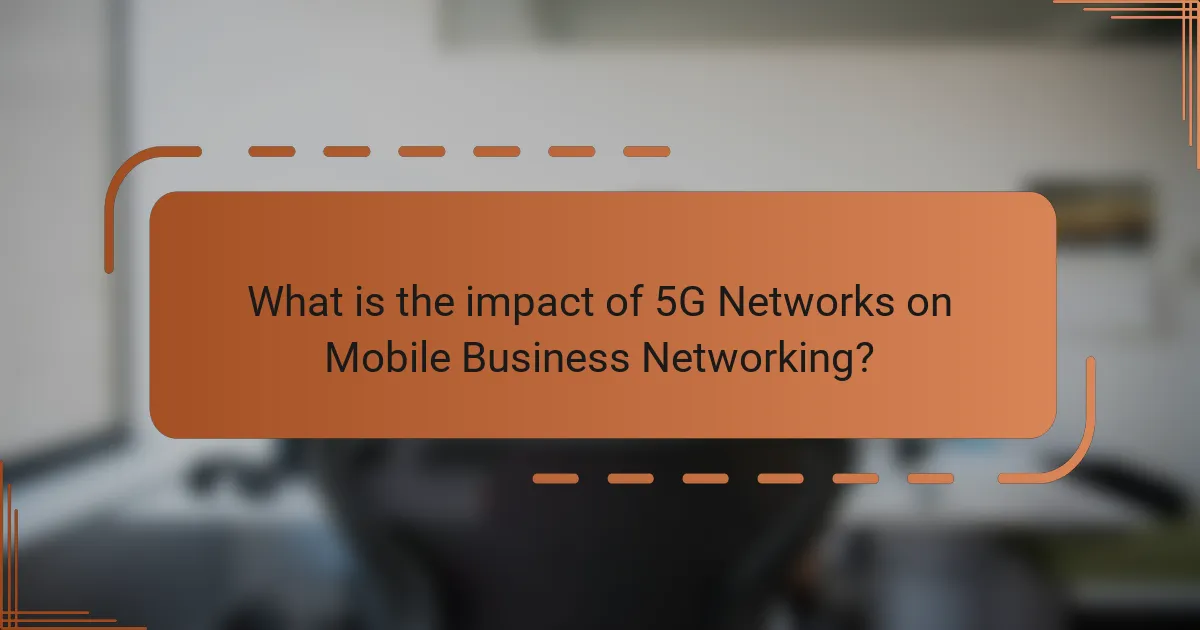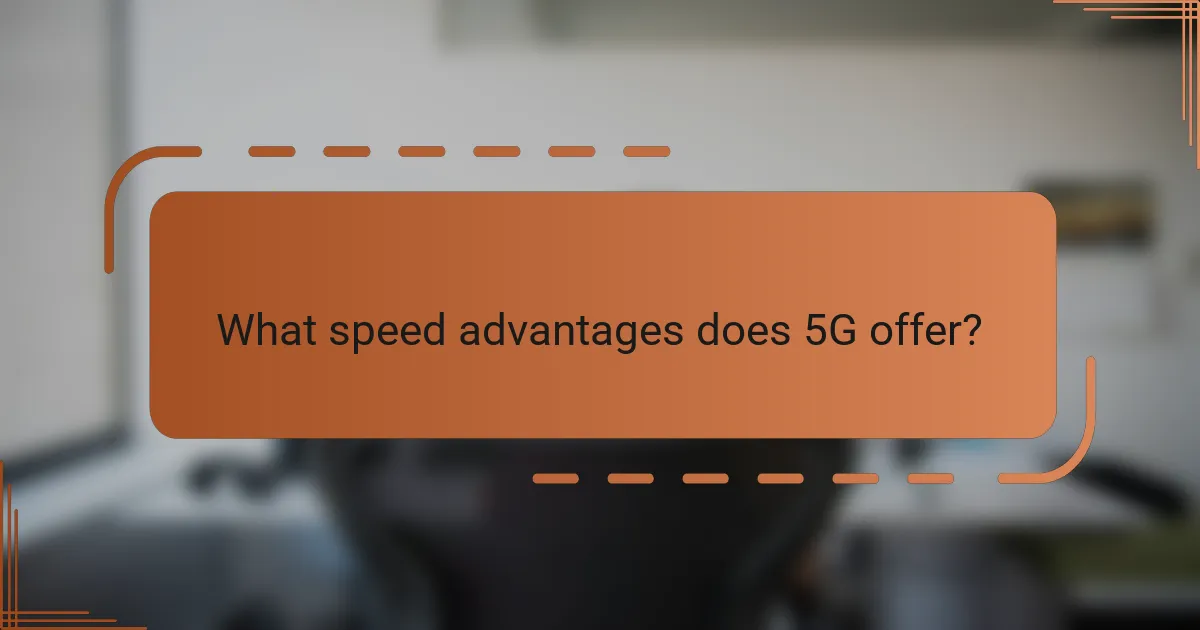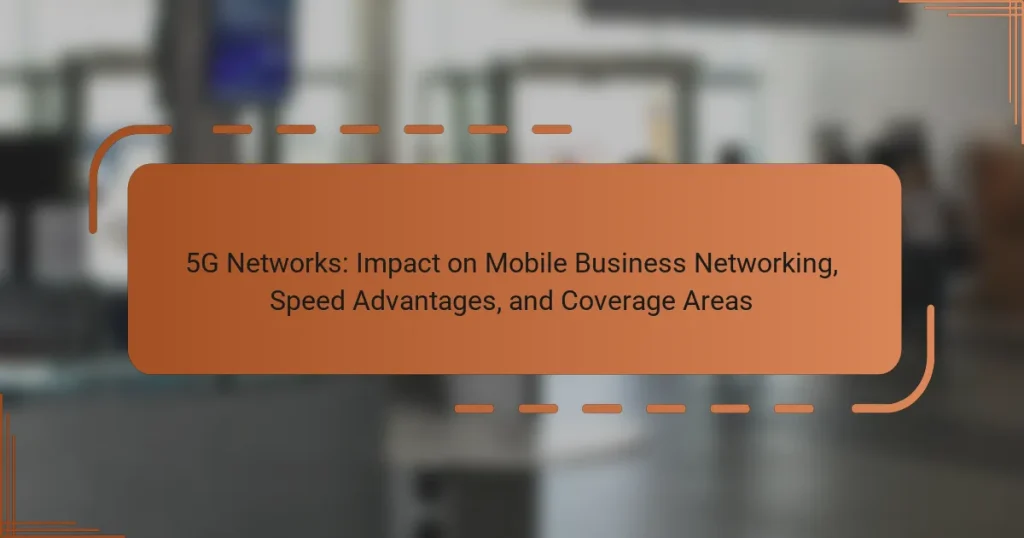5G networks represent the fifth generation of mobile telecommunications technology, offering significantly faster data speeds and lower latency compared to previous generations like 4G. With potential speeds reaching up to 10 Gbps and reduced latency as low as 1 millisecond, 5G enhances real-time communication and supports a higher number of connected devices, making it crucial for applications such as IoT, autonomous vehicles, and smart cities. The coverage of 5G extends across urban, suburban, and rural areas, with ongoing improvements expected to increase accessibility for businesses. This technology is designed to empower mobile business networking by improving operational efficiency and enabling innovative applications in diverse environments.

What are 5G Networks?
5G networks are the fifth generation of mobile telecommunications technology. They provide significantly faster data speeds compared to previous generations like 4G. 5G networks enable lower latency, which enhances real-time communication. They support a higher number of connected devices simultaneously. According to the International Telecommunication Union, 5G can achieve speeds up to 10 Gbps. This technology uses advanced techniques like millimeter waves and massive MIMO. 5G networks are designed to support applications such as IoT, autonomous vehicles, and smart cities. They promise improved coverage and reliability, making them essential for future mobile business networking.
How do 5G Networks differ from previous generations?
5G networks differ from previous generations primarily in speed, latency, and connectivity. 5G offers download speeds up to 10 Gbps, significantly faster than 4G’s maximum of 1 Gbps. Latency in 5G is reduced to as low as 1 millisecond, compared to 30-50 milliseconds in 4G. This low latency enables real-time applications like autonomous vehicles and remote surgery. Additionally, 5G supports a higher density of devices per square kilometer, accommodating up to 1 million devices, while 4G supports around 100,000 devices. The technology also utilizes advanced techniques such as Massive MIMO and beamforming to enhance coverage and efficiency. These improvements collectively enable new applications and services, transforming mobile business networking.
What are the key technological advancements in 5G?
Key technological advancements in 5G include enhanced mobile broadband, ultra-reliable low latency communication, and massive machine-type communication. Enhanced mobile broadband supports higher data rates, reaching up to 10 Gbps. Ultra-reliable low latency communication reduces latency to as low as 1 millisecond. Massive machine-type communication enables connectivity for up to 1 million devices per square kilometer. These advancements facilitate innovations in IoT, autonomous vehicles, and smart cities. 5G networks utilize advanced technologies like beamforming and MIMO (multiple input, multiple output) to improve signal quality and capacity. The deployment of small cells enhances coverage and network efficiency. Overall, these advancements significantly improve mobile networking capabilities.
How does the architecture of 5G enhance performance?
The architecture of 5G enhances performance through advanced technologies such as Massive MIMO and beamforming. Massive MIMO allows for multiple antennas to be used at both the transmitter and receiver, increasing capacity and efficiency. Beamforming directs signals towards specific users, reducing interference and improving signal quality.
Additionally, 5G utilizes a network slicing approach. This enables the creation of virtual networks tailored for specific applications, optimizing resource usage. The low latency of 5G architecture is achieved by reducing the distance data must travel, enhancing real-time communication.
According to a report from the GSMA, 5G networks can achieve download speeds up to 10 Gbps, significantly faster than previous generations. These features collectively contribute to improved user experiences and support for a higher number of connected devices.
What are the core components of 5G Networks?
The core components of 5G networks include the radio access network (RAN), core network, and user equipment. The radio access network connects devices to the core network. It utilizes advanced antennas and small cell technology to enhance coverage and capacity. The core network manages data traffic and services, ensuring efficient communication. User equipment refers to devices like smartphones and IoT devices that access the network. Each component plays a crucial role in delivering high-speed connectivity and low latency. 5G networks aim to support a wide range of applications, from mobile broadband to smart cities.
What role do small cells play in 5G?
Small cells enhance 5G networks by improving coverage and capacity. They are low-power base stations that operate in a smaller area compared to traditional cell towers. Small cells support higher data rates and lower latency, essential for 5G applications. They are strategically placed in urban environments to fill coverage gaps. Research indicates that small cells can increase network capacity by up to 1000 times in dense areas. This makes them crucial for supporting the growing demand for mobile data. Small cells also facilitate the deployment of advanced technologies like IoT and smart cities. Their integration into 5G networks is vital for delivering seamless connectivity and enhancing user experience.
How do antennas and spectrum contribute to 5G functionality?
Antenna technology and spectrum allocation are crucial for 5G functionality. Antennas enable the transmission and reception of radio signals. They are designed to work with higher frequency bands, which are essential for 5G. These higher frequencies allow for faster data rates and lower latency.
Spectrum refers to the range of radio frequencies used for transmitting data. 5G utilizes a broader spectrum compared to previous generations. This includes low-band, mid-band, and high-band frequencies. Each band serves different purposes in terms of coverage and speed.
The combination of advanced antennas and a wide spectrum enhances network capacity. This leads to improved user experience in mobile business networking. For instance, 5G can support more devices simultaneously without degradation in service. This is vital for applications requiring real-time data transmission, like IoT devices and autonomous vehicles.
In summary, antennas facilitate high-frequency communication, while spectrum allocation optimizes data transmission across various applications. Together, they significantly enhance the performance and capabilities of 5G networks.

What is the impact of 5G Networks on Mobile Business Networking?
5G networks significantly enhance mobile business networking by providing faster data speeds, lower latency, and increased connectivity. These improvements allow businesses to operate more efficiently and respond quickly to market changes. With data rates reaching up to 10 Gbps, businesses can transfer large files and stream high-definition content seamlessly. The latency reduction to as low as 1 millisecond enables real-time communication and collaboration among teams. Additionally, 5G networks support more devices simultaneously, which is crucial for IoT applications in business environments. The increased coverage areas ensure that businesses can maintain connectivity in diverse locations, enhancing remote work capabilities. Overall, 5G networks empower mobile business networking by improving operational efficiency and enabling innovative applications.
How does 5G improve mobile business connectivity?
5G improves mobile business connectivity by providing significantly faster data transfer speeds. It offers speeds up to 10 Gbps, which is up to 100 times faster than 4G. This speed enables quicker access to cloud applications and real-time data processing. Additionally, 5G reduces latency to as low as 1 millisecond. This low latency enhances responsiveness for applications that require immediate feedback, such as video conferencing and remote collaboration tools. Furthermore, 5G supports a higher density of connected devices. It can connect up to 1 million devices per square kilometer, facilitating the Internet of Things (IoT) in business environments. Enhanced connectivity leads to improved operational efficiency and productivity in mobile business operations.
What are the implications of lower latency for businesses?
Lower latency significantly enhances business operations. It enables real-time data processing and faster communication. This improvement leads to increased efficiency in decision-making. For example, industries like finance benefit from quicker transaction speeds. Lower latency can also enhance customer experiences through instant responses. According to a study by the GSMA, reduced latency can improve user engagement by up to 30%. Furthermore, businesses utilizing IoT devices can achieve seamless connectivity, optimizing resource management. Overall, lower latency fosters innovation and competitive advantage in various sectors.
How does increased bandwidth benefit mobile applications?
Increased bandwidth significantly enhances mobile applications by allowing faster data transmission. This results in reduced latency, which improves the responsiveness of apps. Higher bandwidth supports more simultaneous connections, benefiting users in crowded environments. It enables the streaming of high-quality video and audio without buffering. Increased bandwidth also facilitates real-time data sharing, essential for collaborative applications. According to a study by Ericsson, 5G networks can provide up to 100 times the bandwidth of 4G, greatly improving user experience. This enhancement is crucial for applications requiring large data transfers, such as cloud computing and augmented reality.
What challenges do businesses face with 5G adoption?
Businesses face several challenges with 5G adoption. The first challenge is the high infrastructure cost. Deploying 5G requires significant investment in new equipment and technology. Many businesses struggle to allocate sufficient budgets for this transition.
Another challenge is the complexity of integration. Companies must adapt existing systems to work with 5G technology. This often requires specialized knowledge and skills that may not be readily available.
Regulatory hurdles also pose a challenge. Different regions have varying regulations regarding 5G deployment. Navigating these regulations can delay implementation and increase costs.
Security concerns are prevalent as well. 5G networks introduce new vulnerabilities that businesses must address. Ensuring data protection and network security is critical for maintaining customer trust.
Finally, there is a lack of widespread coverage. In many areas, 5G networks are still being developed. This limits the immediate benefits businesses can gain from adopting the technology.
What are the security concerns associated with 5G Networks?
5G networks face several security concerns. One major issue is the increased attack surface due to more connected devices. This makes it easier for cybercriminals to exploit vulnerabilities. Another concern is the potential for data interception during transmission. 5G networks use higher frequencies, which can be more easily intercepted. Additionally, the reliance on software-defined networking increases risks related to software vulnerabilities. The use of third-party vendors for infrastructure can also introduce supply chain risks. According to a report by the European Union Agency for Cybersecurity, 5G networks may be more susceptible to denial-of-service attacks. These concerns highlight the need for robust security measures in 5G implementations.
How can businesses overcome infrastructure hurdles?
Businesses can overcome infrastructure hurdles by investing in modern technology and collaborating with service providers. Upgrading existing systems is essential for compatibility with 5G networks. Training staff on new technologies ensures efficient utilization. Partnerships with telecom companies can facilitate better access to resources. Implementing cloud solutions can enhance operational flexibility and scalability. Additionally, leveraging data analytics can optimize resource allocation and infrastructure planning. According to a report by Deloitte, companies that embrace digital transformation see a 20% increase in operational efficiency.

What speed advantages does 5G offer?
5G offers significantly higher speeds compared to previous generations. It can deliver download speeds exceeding 10 Gbps. This is up to 100 times faster than 4G LTE. The increased bandwidth allows for more devices to connect simultaneously without slowing down. 5G technology utilizes higher frequency bands, which contribute to these speed enhancements. Additionally, 5G reduces latency to as low as 1 millisecond. This enables real-time data transmission, which is crucial for applications like autonomous vehicles and remote surgeries. The combination of high speed and low latency enhances mobile business networking capabilities.
How fast is 5G compared to 4G?
5G is significantly faster than 4G. 5G can achieve speeds of up to 10 Gbps. In contrast, 4G typically offers speeds between 10 Mbps and 100 Mbps. This means 5G is up to 100 times faster than 4G. The increased speed of 5G enables quicker downloads and smoother streaming. Additionally, 5G reduces latency to as low as 1 millisecond. This improvement enhances real-time communication and responsiveness. The technology behind 5G, such as millimeter waves, allows for higher data transmission rates. These advancements make 5G a transformative upgrade over 4G.
What factors influence 5G speed in real-world scenarios?
5G speed in real-world scenarios is influenced by several factors. These include network density, which refers to the number of base stations in a given area. More base stations lead to better coverage and higher speeds.
Signal strength is another critical factor. Stronger signals result in faster data transmission. Obstacles such as buildings and trees can weaken signals, reducing speed.
User density also plays a role. High numbers of simultaneous users can lead to network congestion, slowing down speeds.
The frequency band used affects speed as well. Higher frequency bands offer faster speeds but have shorter range and [censured] capabilities.
Finally, device capabilities impact speed. Devices with advanced 5G technology can utilize the network more efficiently, enhancing speed.
These factors collectively determine the actual 5G speed experienced by users in different environments.
How does speed impact user experience in mobile applications?
Speed significantly impacts user experience in mobile applications. Faster speeds lead to quicker load times and smoother interactions. Users expect applications to respond instantly. Research indicates that a one-second delay can reduce user satisfaction by 16%. Additionally, 70% of users abandon an app that takes more than three seconds to load. High-speed connections enhance streaming quality and reduce buffering. This is crucial for applications that rely on real-time data. Overall, speed is a key factor in user retention and engagement.
What are the practical applications of 5G speed in business?
5G speed has numerous practical applications in business. It enables real-time data processing, enhancing decision-making efficiency. Businesses can leverage 5G for IoT device connectivity, allowing seamless communication between devices. High-speed internet facilitates remote work, improving productivity and collaboration. Industries like healthcare benefit from telemedicine, enabling remote consultations with minimal latency. Manufacturing sectors utilize 5G for smart factories, optimizing operations through automation. Retailers can enhance customer experiences with augmented reality applications, driven by fast data transfer. According to a report by Ericsson, 5G can increase mobile broadband speeds by up to 100 times compared to 4G, significantly impacting various business sectors.
How can businesses leverage 5G speed for competitive advantage?
Businesses can leverage 5G speed for competitive advantage by enhancing operational efficiency and customer experiences. 5G technology offers download speeds up to 100 times faster than 4G. This speed enables real-time data processing and instant communication. Businesses can utilize 5G for advanced applications like augmented reality and IoT devices. Enhanced connectivity allows for smarter supply chain management and logistics. Companies can also implement cloud-based services with reduced latency. According to a report by Ericsson, 5G can boost global GDP by $1 trillion by 2030. This economic impact highlights the significant potential of 5G in driving business innovation and growth.
What industries benefit most from enhanced speed capabilities?
The industries that benefit most from enhanced speed capabilities include telecommunications, healthcare, manufacturing, automotive, and entertainment. Telecommunications relies on speed for faster data transmission and improved connectivity. Healthcare benefits from rapid data sharing for telemedicine and real-time patient monitoring. Manufacturing uses speed for automation and efficient supply chain management. The automotive industry enhances vehicle-to-everything (V2X) communication for safer driving. Entertainment leverages speed for high-quality streaming and immersive experiences. These industries experience increased efficiency, improved customer experiences, and enhanced innovation due to speed advancements.

What are the coverage areas of 5G Networks?
5G networks cover urban, suburban, and rural areas. Urban areas typically have the most extensive coverage due to higher population density. Suburban areas receive moderate coverage with ongoing expansion efforts. Rural areas often experience limited coverage, but improvements are being made. The coverage depends on the frequency bands used. Lower frequency bands offer wider coverage but lower speeds. Higher frequency bands provide faster speeds but shorter range. According to the GSMA, global 5G coverage is expected to reach 1.7 billion people by 2025. This indicates significant growth in coverage areas as infrastructure develops.
How is 5G coverage different from previous network generations?
5G coverage differs from previous network generations by offering significantly higher speeds and lower latency. It can achieve download speeds up to 10 Gbps, which is substantially faster than 4G’s maximum of around 1 Gbps. Additionally, 5G networks utilize a wider range of frequencies, including millimeter waves, allowing for greater bandwidth and capacity. This enables more devices to connect simultaneously without degradation in service.
5G also employs advanced technologies like beamforming and massive MIMO, enhancing signal strength and coverage. These improvements lead to more reliable connections in densely populated areas. Furthermore, 5G networks support ultra-reliable low-latency communication, which is crucial for applications like autonomous vehicles and remote surgeries.
In summary, 5G coverage enhances speed, capacity, and reliability compared to earlier generations, meeting the demands of modern mobile applications.
What factors affect the extent of 5G coverage?
The extent of 5G coverage is affected by several key factors. These include the frequency bands used, the density of cell towers, and the geographical terrain. Higher frequency bands provide faster speeds but have a shorter range. For instance, millimeter-wave technology offers high speeds but struggles to penetrate buildings. The density of cell towers is crucial; more towers result in better coverage. Urban areas typically have a higher density of towers than rural areas. Geographical terrain also plays a significant role; mountains and large buildings can obstruct signals. Additionally, environmental factors like weather can impact signal strength. Overall, these factors collectively determine the availability and quality of 5G coverage in different locations.
How do urban and rural areas differ in 5G availability?
Urban areas have significantly higher 5G availability compared to rural areas. Urban regions benefit from dense infrastructure and investment in telecommunications. This results in a greater number of 5G cell towers and nodes. In contrast, rural areas often lack the same level of infrastructure investment. Consequently, 5G coverage in these regions is limited and sporadic. According to the Federal Communications Commission (FCC), as of 2021, about 30% of rural Americans lack access to high-speed internet, including 5G. This stark difference impacts connectivity, speed, and overall user experience in mobile business networking.
What strategies can businesses use to maximize 5G coverage?
Businesses can maximize 5G coverage by strategically deploying small cells. Small cells enhance network capacity and coverage in dense urban areas. They can be installed on existing infrastructure, such as streetlights or utility poles.
Another strategy involves partnering with telecommunications providers. This collaboration can facilitate access to better infrastructure and resources. Businesses should also invest in advanced antenna technology. This technology improves signal strength and reduces interference.
Optimizing network design is crucial for maximizing coverage. Businesses should analyze traffic patterns to identify high-demand areas. Implementing network slicing can also provide tailored connectivity solutions.
Monitoring and upgrading equipment regularly ensures optimal performance. This proactive approach helps address coverage gaps quickly. Utilizing data analytics can inform decision-making regarding network expansion.
According to a report by the GSMA, small cells can increase capacity by up to 1000 times in certain areas. This statistic highlights the effectiveness of deploying small cells for improved coverage.
How can businesses assess their 5G readiness in terms of coverage?
Businesses can assess their 5G readiness in terms of coverage by conducting a comprehensive coverage analysis. This involves evaluating current network infrastructure and identifying existing gaps in coverage. They can utilize tools such as drive tests and signal mapping to measure 5G signal strength in target areas. Additionally, businesses should review coverage maps provided by 5G network operators. According to the GSMA, 5G coverage will expand rapidly, but readiness varies by region. Therefore, understanding local 5G deployment status is crucial. Regular assessments will help businesses align their strategies with evolving 5G availability.
What role do partnerships play in expanding 5G reach?
Partnerships play a crucial role in expanding 5G reach. They enable collaboration between telecom providers, technology companies, and infrastructure developers. This collaboration accelerates the deployment of 5G networks across various regions. Partnerships help in sharing resources and expertise, which reduces costs and speeds up implementation. Additionally, they facilitate access to new markets and customer bases. For instance, joint ventures can leverage existing infrastructure to enhance coverage. The combination of different technologies through partnerships can also lead to innovative solutions that enhance 5G capabilities. Overall, partnerships are essential for overcoming challenges in 5G rollout and ensuring widespread adoption.
What best practices should businesses follow for 5G implementation?
Businesses should follow several best practices for 5G implementation. First, they must conduct a thorough assessment of their current infrastructure. This helps identify gaps that 5G can fill. Second, businesses should engage with reliable telecom partners. These partners can provide essential support and guidance during the transition. Third, companies need to prioritize security measures. 5G networks introduce new vulnerabilities that require robust security protocols. Fourth, businesses should invest in employee training. This ensures staff can effectively utilize the new technology. Fifth, organizations should develop a clear roadmap for deployment. A strategic plan helps in managing resources and timelines. Lastly, businesses should continuously evaluate performance post-implementation. Regular assessments help optimize the 5G network for maximum efficiency. These practices are crucial for leveraging the full potential of 5G technology.
5G networks represent the fifth generation of mobile telecommunications technology, offering significantly faster data speeds, lower latency, and enhanced connectivity compared to previous generations. This article explores the impact of 5G on mobile business networking, highlighting speed advantages that reach up to 10 Gbps and latency reductions to as low as 1 millisecond, which are crucial for real-time applications. Additionally, it examines coverage areas, noting the differences in availability between urban and rural settings, and discusses the key components, technological advancements, and challenges businesses face in adopting 5G technology. Overall, the article provides a comprehensive overview of how 5G networks are transforming mobile business operations and connectivity.


